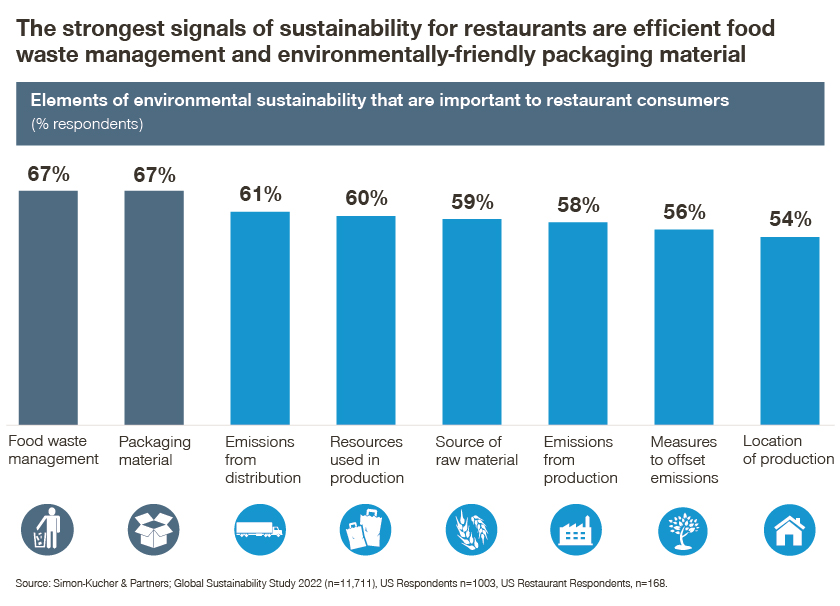Younger consumers are willing to pay an average premium of 20 percent for sustainable meals - what does this mean for restaurants pursuing eco-aware diners?
The willingness to pay for sustainability in restaurants is likely to continue to grow as consumers become more educated about environmental impact and as sustainable options become more widely available. However, the willingness to pay for sustainability in restaurants varies among generations and differing factors such as personal values, income, and the perceived importance of sustainability. The opportunities are there for the restaurant sector to use this as an opportunity to meet consumer need and use sustainability as a growth opportunity.
Our recent US Restaurant Sustainability Study revealed that being environmentally conscious is important for restaurant consumers who are willing to pay a premium for more eco-friendly and green restaurant choices.
Restaurants have an opportunity to expand eco-friendly services, and charge a higher price premium
The average price premium for environmentally sustainable meals in restaurants is 20 percent. Most consumers are willing to pay over 10 percent price premium to dine at a green restaurant.
While most consumers are willing to pay over 10 percent price premium to dine at a green restaurant, our study reveals the average price premium for environmentally sustainable meals in restaurants is 20 percent.
We broke down that willingness to pay into three levels: high (over 20 percent), medium (11 – 20 percent), and low (1 –10 percent).

- Among the “Baby Boomer” generation (ages 59 to 77), we found that 73 percent of respondents were willing to pay a 1 to 10 percent price premium. The remaining 27 percent of respondents were happy to pay a bit more, between 11 to 20 percent, for their meals and services.
- 37 percent of “Gen X” respondents (ages 43 to 58) showed a medium willingness to pay, while 63 percent were only willing to pay a 1 to 10 percent price premium.
- Compared to the earlier generations, “Millennials” (ages 27 to 42) and “Gen Z” (ages 11 to 26) are willing to pay even more for sustainability. We found that 36 percent of Millennials and 50 percent of Gen Z reported being prepared to pay more than 20 percent price premium for green restaurants.
- Another 36 percent of Millennial respondents reported at least a medium willingness to pay. Only 29 percent of Millennials reported expecting to pay less than a 10 percent premium on sustainable restaurants. Similarly, 17 percent of our Gen Z respondents had a medium willingness to pay, with the remaining 33 percent showing low willingness to pay.
So, what does this all mean? Younger generations are more willing to pay a higher price premium for sustainable meals.
One thing is clear, consumers’ willingness to pay premium prices for sustainable options is growing. However, this willingness to pay is not evenly distributed across all demographics.
Measuring sustainability in restaurants
As far as evaluating efforts toward green practices, consumers want restaurants to prove their commitment to sustainability through concrete actions. As a food service business, you can take different steps to minimize your company’s impact on the planet and the environment. General sustainability communication does not compare to tangible actions.
Our study shows that certain sustainable practices resonate with consumers more than others, with the strongest preference for sustainable practices received votes from 67 percent of respondents, equally 1) efficient food waste management, and 2) environmentally friendly packaging.

How should restaurants respond to this information?
Restaurants should look at this as an opportunity to incorporate sustainable practices into their day-to-day business operations to find balance between meeting the needs of diners and growing their businesses. Communicating these initiatives will be instrumental in connecting with the eco-aware and Gen Z consumers.
- Communicate efforts on food waste management and sustainable ingredients on packaging
- Utilizing in-store and digital channels to deliver messaging on sustainability initiatives to younger consumers
- Price menu items based on the sourcing and sustainability of the ingredients
Other green practices adopted by restaurants, (and which have proven important to consumers), include taking steps to reduce emissions created during distribution and production. Organizations can choose greener options by being mindful of production resources and the sources of their raw materials. Additionally, your organization can take measures to offset emissions, as well as ensuring that your locations of production are not problematic.
Taking these measures will help to ensure that your company is making a genuine effort to build a sustainable restaurant business.
Sustainability has become the new normal, and consumers’ growing interest in engaging in sustainable practices should be enough to convince businesses to begin taking steps in that direction. It’s time for food service businesses to make concrete plans to go green and offer consumers better, healthier, and more sustainable choices.
If you would like more information on this topic, reach out to us today.
Contributing Author:
- Erin Kilbride, Senior Consultant
